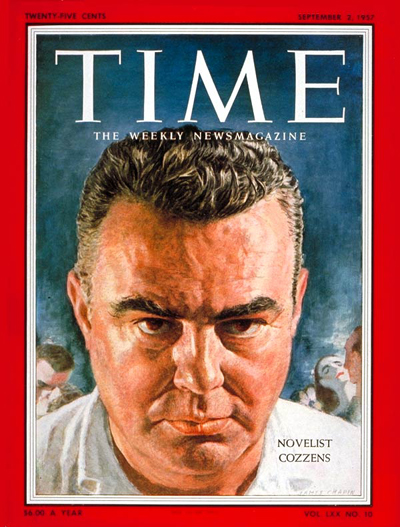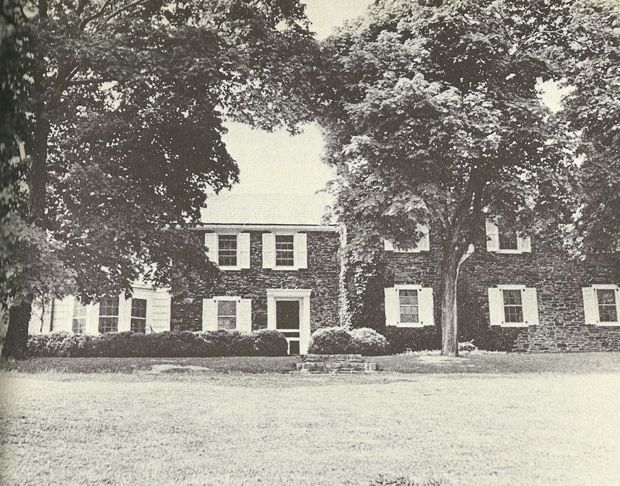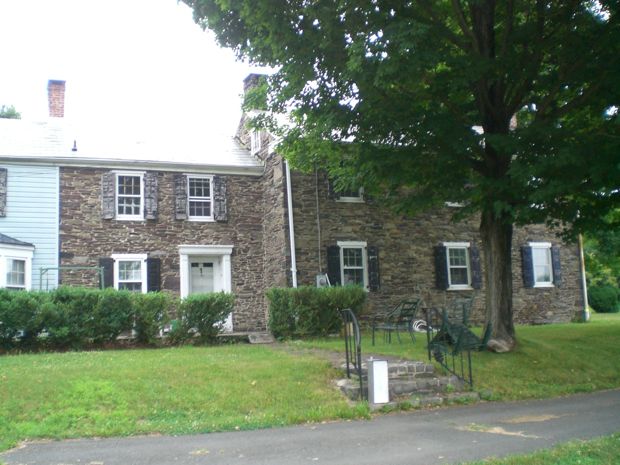
Following his passion for the work of novelist James Gould Cozzens, Paul Zahl recently made a pilgrimage to Lambertville, New Jersey, where the reclusive Cozzens lived and worked and hid out from the world. Here is the first part of Paul's report from a country he has named in honor of one of the strange lands visited by Lemuel Gulliver in his travels:
“A VOYAGE TO THE COUNTRY OF THE HOUYNHNMS” — Part One
James Gould Cozzens (1903-1978) admired Jonathan Swift beyond almost all other writers. He also agreed with Swift's view of human nature. Like Swift, though not as extreme as he, Cozzens was a misanthrope. [Swift's Gulliver, it will be remembered, preferred the Houyhnhnms, a race of intelligent horses, to any of the more human creatures whose lands he visited.] He was also a hermit.
In 1957 a Time magazine cover story called Cozzens “The Hermit of Lambertville”.
Because I like Cozzens' novels, among them By Love Possessed, Guard of
Honor, and Men and Brethren, I decided to see if I could locate the
house, outside Lambertville, New Jersey, in which the great one, who
didn't like people, wrote these books.
Because Cozzens' literary reputation took a nose dive in 1958, and has
not risen again, there is little to go on. Matthew J. Bruccoli
published the sole biography of the man in 1983, and in it there is a
photograph of the Lambertville house, known then as “Carrs Farm”, in
which Cozzens and his wife lived from 1933-1958. But I could find
nothing more — no address nor further specifics, of any kind.
Therefore, on June 12, 2010, I took the opportunity of being in
Princeton to borrow a car and drive the 40 minutes or so over to
Lambertville in search of Carrs Farm. I knew it was about three miles
outside of town, on a country lane called Goat Hill Road. Calls to the
Episcopal rector of Lambertville and to the Hunterdon Country
Historical Society had been returned but no one seemed to know anything
about Cozzens nor the 25 years the once famous writer had been living
in their community.
Or almost no one.
Early on a misty Saturday I drove the back roads from Princeton through
Lawrenceville then through more or less soft and hilly country, to the
end of Goat Hill Road. Several large houses, with spacious lawns and
well kept gardens, were hidden from the road. I did carry a photograph
of Carrs Farm, fortunately, taken from the Bruccoli biography:

But everything was too hidden away to see.
Then, behold: a nice lady taking her morning walk. I stopped the car
and asked after my man. She said, well, if you mean the fellow who
wrote a novel about World War II, I've heard he lived somewhere along
this road. I think it's the house at the bottom of the hill, on the
left. Furthermore, a half mile or so the other way, at the top of the hill, you may find a
gentleman at home who has lived here for many years and knows
everything.
And so it was! My walker was right. Right at the bottom of the hill was Carrs Farm.
When I got out of the car, I noticed that “Keep Out” and “No
Trespassing” and “Private Property” signs were pointedly posted at the
entrance to the farm. Was there a regular army of Cozzens-enthusiasts
I didn't know about, who had disturbed the peace of the current owner?
(I later found out there were other reasons for the signs.) But I
slipped in anyway, prepared to be the nice interested clergyman that I
hope I am, if an owner came upon me. The owner didn't, but the owner's
friend did, who did not know about Cozzens but warned me to get out
of there fast. I took the one photograph of the exterior, on the run; and
it sure is the house:

That's for sure. And almost completely unchanged, but for a metal rail
at the steps and the boxwoods cut differently. Cozzens himself would
not have welcomed visitors either, as he apparently lived only to write
and think, albeit happily married to his wife, a literary agent who
commuted Monday through Friday into Manhattan.
Oh, and Cozzens would write in the mornings and garden in the
afternoon. Like his characters Arthur Winner, Jr. and Arthur Winner,
Sr. in By Love Possessed, the man cultivated roses, antique roses, to
be specific, with dedication.
After breathing a sigh of relief, for one had found what one was
looking for, and had not been beaten away with brooms, I decided to walk up in the opposite direction and pay
a call on the man on the hill. He was, as it turned out, no fool.
[Click here for the second part of this report, in which our intrepid pilgrim meets the wise man on the hill, who imparts knowledge, and ventures into Lambertville itself, searching for traces of the small town its famous hermit once knew.]

Dear Paul,
I hope you see this comment. It's your old friend Eileen Lynch tracking you down again. As it happens, I lived three years in Lambertville (1995 through 1998) and loved it. I lived very near the little square you photographed…at least i think so, the angle is a little different from my accustomed one, but I think you photographed on York Street and I lived on Coryell, the next street south.
I was also amazed to see that your notebook (which contains a sample of the famous tiny Zahl script I remember so well) refers to a Miss Lanoue. Or at least that's what it looked like to me. Can't help but wonder who she was, since my grandmother's maiden name was LaNoue (a Baton Rouge family) and we are almost all related one way or another.
I would love to catch up. I am living in Philadelphia, teaching Spanish at the University of Pennsylvania, and attending St. John the Evangelist Anglican in Churchville, PA (Phil Lyman's former parish).
Please get in touch if you get a chance,
Love to Mary, and to you,
Eileen
276-844-1672 (home)
215-923-2550 (cell)
tessalynch@comcast.net